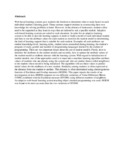Comparison of Different Machine Learning Algorithms for the Initialization of Student Knowledge Level in a Learner Model-Based Adaptive E-Learning System

View/
Date
2009Author
Oboko, Robert O
Wagacha, Peter W
Omwenga, Elijah
Type
ArticleLanguage
enMetadata
Show full item recordAbstract
Web-based learning systems give students the freedom to determine what to study based on each
individual student’s learning goals. These systems support students in constructing their own
knowledge for solving problems at hand. However, in the absence of instructors, students often need to
be supported as they learn in ways that are tailored to suit a specific student. Adaptive web-based
learning systems are suited to such situations. In order for an adaptive learning system to be able to
provide learning support, it needs to build a model of each individual student and then to use the
attribute values for each student as stored in the student model to determining the kind of learning
support that is suitable for each student. Examples of such attributes are student knowledge level,
learning styles, student errors committed during learning, the student’s program of study, gender and
number of programming languages learned by the student of programming. There are two important
issues about the use of student models. Firstly, how to initialize the attributes in the student models and
secondly, how to update the attribute values of the student model as students interact with the learning
system. With regard to initialization of student models, one of the approaches used is to input into a
machine learning algorithm attribute values of students who are already using the system and who are
similar (hence called neighbors) to the student whose model is being initialized. The algorithm will use
these values to predict initial values for the attributes of a new student. Similarity among students is
often expressed as the distance from one student to another. This distance is often determined using a
heterogeneous function of Euclidean and Overlap measures (HOEM). This paper reports the results of
an investigation on how HOEM compares to two different variations of Value Difference Metric
(VDM) combined with the Euclidean measure (HVDM) using different numbers of neighbors. An
adaptive web-based learning system teaching object oriented programming was used. HOEM was
found to be more accurate than the two variations of HVDM.
Citation
International Journal of Computing and ICT Research, Vol. 3, No. 1Publisher
Faculty of Psychology and Educational Sciences, Free University of Brussels School of Computing and Informatics
Subject
Learner modelinginitialization
web-based learning
overlap measure
knowledge level
object oriented programming
value difference metric
